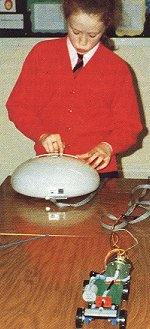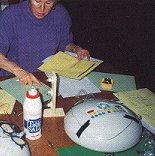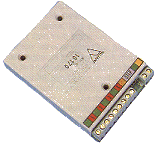
|
Feedback Form

ROAMER CONTROL BOX APPLICATIONS
 Desi
Donnelly, Advisory Teacher for the South Eastern Education and Library
Board, Northern Ireland, is a great exponent of the Roamer and Roamer
control. Here he passes on some ideas that he has developed through his
work with teachers and pupils.
Desi
Donnelly, Advisory Teacher for the South Eastern Education and Library
Board, Northern Ireland, is a great exponent of the Roamer and Roamer
control. Here he passes on some ideas that he has developed through his
work with teachers and pupils.
 Driving and steering buggy using Roamer "T" & "M" commands. |
I have had my Roamer control box for about a year and find it a very exciting addition to the Roamer world. In fact I would go so far as to say that Primary teachers should forget about computer driven buffer boxes using discs; spaces and words. The simple mathematical-based Roamer control language is more efficient and universal. Having dispensed with the need for "switch on (space) this" or "switch off (space) that", a Japanese child could handle Roamer instructions as easily as a British child. Furthermore a Roamer can be so easily shared among classes that the same robot that may have been doing simple number-lines with infants in the morning can be doing sophisticated control-work with older children in the afternoon. When your control box can become a little character and interact with the device it is controlling, this adds creativity to design and technology.
The Roamer control box works on a 6 Volt system and this means that a lot of the school's science kits can be plundered for bulbs, bells, motors, buzzers etc. Unlike buffer boxes no special plugs are needed to join these to Roamer. A few bulbs could be coloured red, amber and green with overhead projector pens and, with the judicious use of Blu-tak, a Roamer can act as a set of traffic lights. I have had seven year old children capably program the sequence at traffic lights.
If you add a buzzer to the three lights you can go on to explore pelican crossings and their advantages to blind people. More advanced work can involve using inputs to influence the lights.
The Valiant light pack has a selection of bulbs, light-emitting diodes (LED's) and a flasher unit. I have seen the yellow LED's and the flasher unit used to make indicators on Roamer cars as they turn corners. The flasher unit allows the indicators to be programmed to work as the Roamer moves along. An alternative that I have used is the flashing bulbs, such as would be used in Christmas tree lights. If you put one flasher bulb in a series of normal bulbs they will all flash. (Get your overhead projector pens out and create a mobile disco complete with flashing coloured lights and Roamer music!) Recently I have come across special LED's that can change colour. They are called bi-colour and tri-colour LED's. A bi-colour LED is the little light on a photocopier that changes from red to green when the machine warms up. The tri-colour LED can change from red, to amber, to green using just two outputs. Output 1 = red, Output 2 = green, Output 1 + Output 2 = amber. These LED's work on 3 volts so you will need 2 resistors to step down the 6V output to 3V. They will work at 6V but the colours will not be the same. An old reflector off a torch (or kitchen foil) greatly enhances the brightness of LED's.
I recently received delivery of the Valiant stepper motor and have used it in a Lego buggy to turn rack and pinion steering. The buggy can run forward or back and can steer as it runs.
 Roamer driving traffic light and lighthouse at KS2 in-service technology course. |
When working with ordinary motors it is possible to achieve a fine control by using a command that is shorter than WAIT 1. This is done by creating an empty procedure sic. Pl[Rl[ ]]. What you have done is to direct the Roamer to do nothing once. The Wait can be made longer by increasing the repeat instruction. Another method of making a Wait less than one second is to use musical note 14 which is a musical rest whose length can be varied. Although a Roamer cannot handle recursion in control, as a buffer box can, you can achieve an almost continuous performance by putting multiple Repeat 99 instructions inside each other. eg. R99 [ R99 [Tl 2 W3 Tl 1]].
Have you ever seen a talking Roamer? They exist. Many schools have old cassette recorders lying around. These may be left-over from the days when computers were programmed by cassette rather than by disk. If these old machines have a 6V dc input which allowed them to be driven from a mains transformer, as well as from the wall socket, then the Roamer control box can drive them if the "play" button is left pushed on. This allows children to tape a message on the cassette which can be activated from the Roamer. For example, if a light is switched on in a room, the Roamer can be activated through a light sensitive switch to turn on a tape saying "Intruder on the premises!" a mercury tilt switch could be used so that that a Roamer could protest vehemently if anyone lifts it up. A single Roamer could be able to play a canon or a round like "London's Burning" by first taping the Roamer music on a cassette recorder, have the Roamer start the recorder and then join in with its recording a bar or so later. A Roamer can tow its tape recorder behind it or a small "walkman" can be attached with tiny speaker to a Roamer jacket. But be careful, many "walkmans" work off a 3V system and could be damaged if 6 volts are used without a resistor.
 The Control Box fits neatly to the underside of Roamer, providing 4 outputs for motors lights etc., an input for sensors and a stepper motor port. This means that children can create robot characters that will react to their environment. A cheap, exciting and easy way to develop control technology in the classroom. |
Many of these constructs seem complicated, but I feel that the designs and ideas that teachers and children come up with are more wonderful than the actual technology. A class studying mini-beasts may transform a Roamer into a large wasp with a reed switch on its side. The child takes an aerosol of insecticide and sprays it on the wasp which immediately turns away. The pretend can of aerosol, of course, has a magnet attached which activates the reed switch. A class may program a Roamer to sound an alarm when a child creeps past it. A light sensitive switch (LDR) has been put in a Smarties tube and pointed towards the daylight. When a child moves between the window and the LDR, the light is cut down and the Roamer senses it.
Children can also experiment further with the light beam from a torch and the LDR in the tube. You can adjust the sensitivity of the LDR by adding layers of sellotape over it to cut down light reception. The Valiant light sensors can have their sensitivity adjusted very easily with a simple screwdriver.
A class may be studying the Spectrum for their science. Children use a computer art package to make discs with different colour combinations and then use the Roamer to spin them on a motor. They try different shapes, spirals, concentric circles etc. They spin the discs clockwise and anticlockwise. The lesson doesn't really feature Roamer a lot. Roamer is used because it is there and can handle the spinning motions easily with a minimum of organisation.
As time goes by teachers are finding more and more uses for the Roamer. The Roamer and its control box may seem a complex piece of apparatus to us, but children adapt to it naturally. There is no element of technophobia - how could one be afraid of a cute little creature that is fun? As hardware becomes cheaper, sophistication is becoming more accessible to younger children. Remote control televisions, for example, were almost unheard of ten years ago. Perhaps in the next decade our Roamers will be able to recharge themselves through solar power and be able to use inputs and outputs without the existence of wires. Certainly every child will have his own robot that reflects his personality and tastes. Roamer certainly has a bright future.
| Back |
|---|